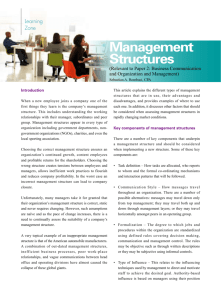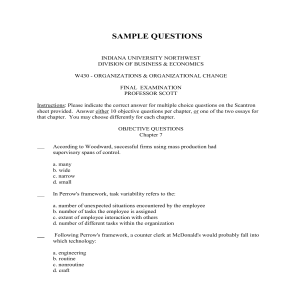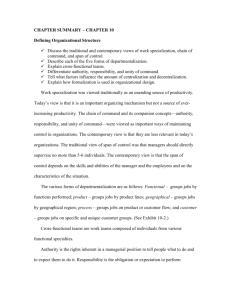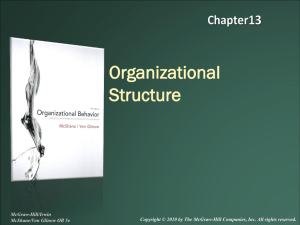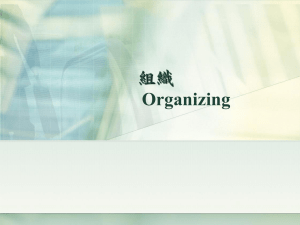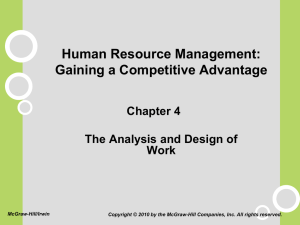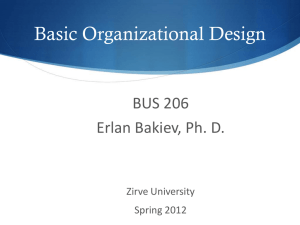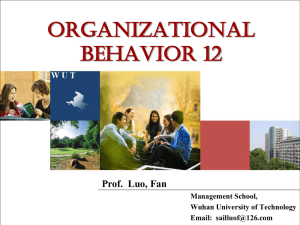Mechanistic-Organic Organizations—An Axiomatic Theory: Authority
advertisement
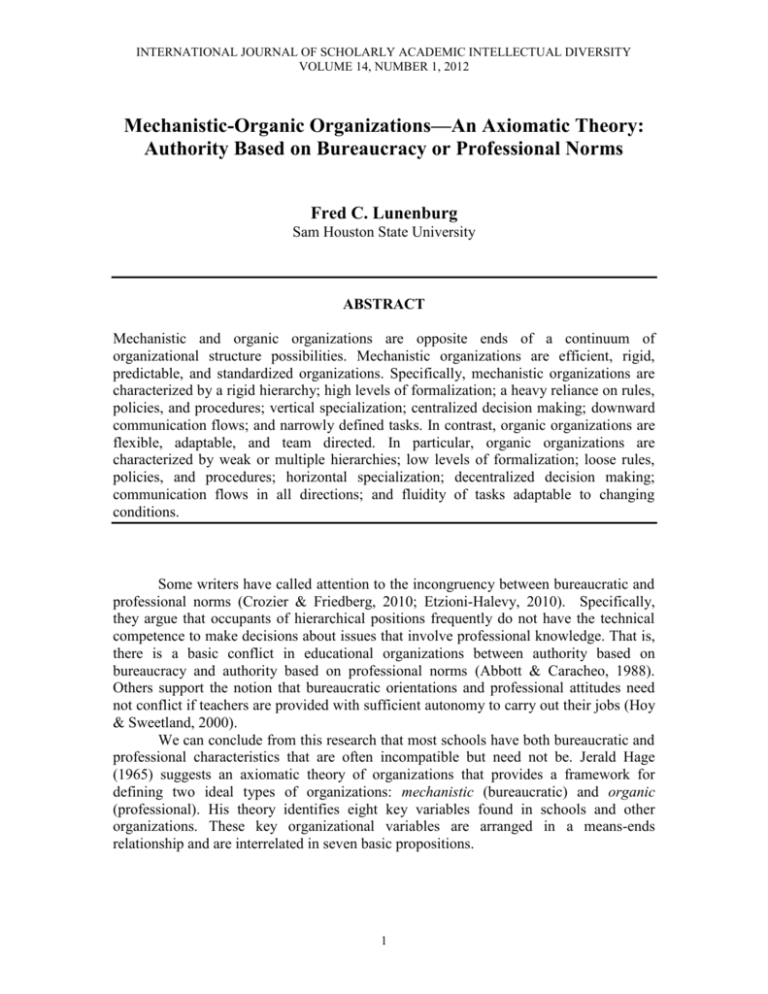
INTERNATIONAL JOURNAL OF SCHOLARLY ACADEMIC INTELLECTUAL DIVERSITY VOLUME 14, NUMBER 1, 2012 Mechanistic-Organic Organizations—An Axiomatic Theory: Authority Based on Bureaucracy or Professional Norms Fred C. Lunenburg Sam Houston State University ABSTRACT Mechanistic and organic organizations are opposite ends of a continuum of organizational structure possibilities. Mechanistic organizations are efficient, rigid, predictable, and standardized organizations. Specifically, mechanistic organizations are characterized by a rigid hierarchy; high levels of formalization; a heavy reliance on rules, policies, and procedures; vertical specialization; centralized decision making; downward communication flows; and narrowly defined tasks. In contrast, organic organizations are flexible, adaptable, and team directed. In particular, organic organizations are characterized by weak or multiple hierarchies; low levels of formalization; loose rules, policies, and procedures; horizontal specialization; decentralized decision making; communication flows in all directions; and fluidity of tasks adaptable to changing conditions. Some writers have called attention to the incongruency between bureaucratic and professional norms (Crozier & Friedberg, 2010; Etzioni-Halevy, 2010). Specifically, they argue that occupants of hierarchical positions frequently do not have the technical competence to make decisions about issues that involve professional knowledge. That is, there is a basic conflict in educational organizations between authority based on bureaucracy and authority based on professional norms (Abbott & Caracheo, 1988). Others support the notion that bureaucratic orientations and professional attitudes need not conflict if teachers are provided with sufficient autonomy to carry out their jobs (Hoy & Sweetland, 2000). We can conclude from this research that most schools have both bureaucratic and professional characteristics that are often incompatible but need not be. Jerald Hage (1965) suggests an axiomatic theory of organizations that provides a framework for defining two ideal types of organizations: mechanistic (bureaucratic) and organic (professional). His theory identifies eight key variables found in schools and other organizations. These key organizational variables are arranged in a means-ends relationship and are interrelated in seven basic propositions. 1 INTERNATIONAL JOURNAL OF SCHOLARLY ACADEMIC INTELLECTUAL DIVERSITY 2_____________________________________________________________________________________ Eight Organizational Variables Complexity, centralization, formalization, and stratification are the four variables that constitute the organizational means by which schools are structured to achieve objectives. Adaptiveness, production, efficiency, and job satisfaction are the four variables that represent categories for sorting organizational ends. Let’s examine each one more closely. Complexity Complexity, or specialization, refers to the number of occupational specialties included in an organization and the length of training required of each. Person specialization and task specialization distinguish the degree of specialization. A teacher who is an expert in English literature is a person specialist, whereas one who teaches eleventh-grade English is a task specialist. The greater the number of person specialists and the longer the period of training required to achieve person specialization (or degree held), the more complex the organization. Centralization Centralization, or hierarchy of authority, refers to the number of role incumbents who participate in decision making and the number of areas in which they participate. The lower the proportion of role incumbents who participate and the fewer the decision areas in which they participate, the more centralized the organization. Formalization Formalization, or standardization, refers to the proportion of codified jobs and the range of variation that is tolerated within the parameters defining the jobs. The higher the proportion of codified jobs in organizations and the lesser range of variation allowed, the more formalized the organization. Stratification Stratification, or status system, refers to the difference in status between higher and lower levels in the organization’s hierarchy. Differentials in salary, prestige, privileges, and mobility usually measure this status difference. The greater the disparity in rewards between the top and bottom status levels and the lower the rates of mobility between them, the more stratified the organization. Adaptiveness Adaptiveness, or flexibility, refers to the use of professional knowledge and techniques in the instruction of students and the ability of a school to respond to FRED C. LUNENBURG _____________________________________________________________________________________3 environmental demands. The more advanced the knowledge base, instructional techniques, and environmental response, the more adaptive the organization. Production Production refers to the quantity and quality of output. Some organizations are more concerned with quantity and less concerned with quality, and vice versa. This variable is difficult to measure because of the dichotomy between quantity and quality. For example, some universities are “degree mills”; that is, they award a large number of degrees each year with little concern for quality. Other institutions are less concerned about increasing the quantity of degrees awarded and more concerned about the quality of the product (the knowledge acquired by the degree recipient). The greater the emphasis on quantity, not quality of output, the more productive the organization. Efficiency Efficiency, or cost, refers to financial as well as human resources and the amount of idle resources. For example, class size ratios of one teacher to 30 students are more efficient than one-to-ten ratios. The lower the cost per unit of production, the more efficient the organization. Job Satisfaction Job satisfaction, or morale, refers to the amount of importance an organization places on its human resources. Measures of job satisfaction include feelings of wellbeing, absenteeism, turnover, and the like. The higher the morale and the lower the absenteeism and turnover, the higher the job satisfaction in the organization. Seven Organizational Propositions Central to Hage’s axiomatic theory are seven propositions, which have been drawn from the classic works of Max Weber (1947), Chester Barnard (1964), Charles Perrow, 1972, and Victor Thompson (1961). The major theme permeating Hage’s theory is the concept of functional strains, namely that maximizing one organizational-means variable minimizes another. The eight key variables are related in fairly predictable ways. For instance, high centralization results in high production and formalization, high formalization in turn results in high efficiency, high stratification results in low job satisfaction and adaptiveness and high production, and high complexity results in low centralization. These ideas are expressed in seven propositions: The higher the centralization, the higher the production. The higher the formalization, the higher the efficiency. The higher the centralization, the higher the formalization. The higher the stratification, the higher the production. INTERNATIONAL JOURNAL OF SCHOLARLY ACADEMIC INTELLECTUAL DIVERSITY 4_____________________________________________________________________________________ The higher the stratification, the lower the job satisfaction. The higher the stratification, the lower the adaptiveness. The higher the complexity, the lower the centralization. Two Ideal Types: Mechanistic—Organic The interrelationship of the eight key variables in seven basic propositions was used to define two ideal types of organizations, as Table 1 indicates. Mechanistic and organic concepts are organizational extremes that represent pure types not necessarily found in real life. No organization is completely mechanistic (bureaucratic) nor completely organic (professional). Most organizations fall somewhere between these two extremes. Table 1 Characteristics of Mechanistic and Organic Organizational Forms Mechanistic Organization Organic Organization (Bureaucratic) (Professional) ________________________________________________________________________ Low complexity High complexity High centralization Low centralization High formalization Low formalization High stratification Low stratification Low adaptiveness High adaptiveness High production Low production High efficiency Low efficiency Low job satisfaction High job satisfaction ________________________________________________________________________ Bureaucratic-type schools tend to have a hierarchical structure of control, authority, and communication with little shared decision making (high centralization). Each functional role requires precise definitions of rights and obligations and technical methods (high formalization). These schools emphasize status differences between hierarchical levels in the organization (high stratification); and an emphasis on quantity, not quality, of output at least cost is prevalent (high production, high efficiency). There is little emphasis on professional expertise in both subject-matter knowledge and instructional methodology (low complexity). As well, there is little responsiveness to changing needs of students, society, and subject matter (low adaptiveness); and human resources are of little importance (low job satisfaction). The ideal professional-type school is characterized by high complexity, adaptiveness, and job satisfaction. That is, school administrators respect the professional knowledge of teachers, respond readily to the changing needs of the school and society, and consider the intrinsic satisfaction of teachers to be an important school outcome. Furthermore, centralization is low because administrators encourage teacher participation FRED C. LUNENBURG _____________________________________________________________________________________5 in decision making and delegate considerable authority and responsibility to teachers in the operation of the school. A network structure of control, authority, and communication prevails. School administrators adjust and continually redefine tasks and avoid always “going by the book.” The organization deemphasizes status differences among the occupants of the many positions in the hierarchy and adopts a collegial, egalitarian orientation. Low efficiency and productivity also characterize the ideal professional school. School administrators in the professional-type school are not as concerned with the quantity of output as they are with the quality of outcomes. Professional-type schools are probably more expensive to operate than bureaucratic-type schools because professional-school administrators tend to deemphasize quantity of output at least cost. Such schools tend to be less efficient but more effective. Each ideal type of school has advantages and disadvantages. Moreover, there are limits on how much a school administrator can emphasize one variable over another. For example, if there is no codification of jobs (formalization), then a condition of normlessness prevails, which will likely result in low job satisfaction among faculty members. If schools do not respond to the knowledge explosion, technological innovations, and the changing needs of students and society, schools are apt to fail in the face of an ever-changing environment. Conversely, too high a change rate is likely to result in increased costs involved in implementing new programs and techniques. Limits exist on each of the eight variables, beyond which a school dare not more. Hage (1965) expresses it this way: “Production imposes limits on complexity, centralization, formalization, stratification, adaptiveness, efficiency, and job satisfaction” (p. 307). In other words, extremes in any variable result in the loss of production, even in a school that has the means to maximize this end. All the relationships specified in the seven propositions are curvilinear. For instance, if centralization becomes too high, production drops; if stratification becomes too low, job satisfaction falls. Therefore, exceeding the limits on any variable results in a reversal of the hypothesized relationships specified in the seven propositions. According to Hage (1965), “these represent important qualifications to the axiomatic theory” (p. 307). The tension between the mechanistic (bureaucratic) and organic (professional) model is constantly negotiated between teachers and administrators. Sometimes it is resolved in favor of professionals, and sometimes it is resolved in favor of administrators (Bacharach, Reeves, & Guerard, 2000). Implications for Practice Because schools are fragile political coalitions, each decision must be considered strategically, examining its implications for all the major stakeholders (Lunenburg & Ornstein, 2012). Thus, school administrators must examine several strategic questions before a professional-school orientation can be effectively implemented (Conley & Bacharach, 1990). INTERNATIONAL JOURNAL OF SCHOLARLY ACADEMIC INTELLECTUAL DIVERSITY 6_____________________________________________________________________________________ 1. In which decisions will professional teachers become involved? There appears to be general agreement among the major stakeholders that teachers should be more involved in making decisions. However, we need to specify the areas in which teachers will play larger roles in decision making. 2. Who will make what decisions in the school? How much influence should teachers have with respect to decisions affecting other parties in the school—students, teachers, support staff, principals, central office administrators, school board members? The roles of these stakeholders may need to be clarified or redefined in a professional-school structure. 3. What are the basic tasks of administrators and teachers in the context of a professional-school structure? Put another way, what is the basis of teachers’ expertise and professional identity? The amount of participation in decision making probably should be contingent of whether the issue is relevant to teachers and whether teachers have the expertise to make the decision. 4. What is the role of teacher unions in a professional-school structure? The involvement of teacher unions is a key strategic issue in structuring a professionalschool orientation. Conclusion Mechanistic and organic organizations are opposite ends of a continuum of organizational structure possibilities. They represent pure types not necessarily found in real life. Mechanistic organizations are efficient, rigid, predictable, and standardized organizations. In particular, mechanistic organizations are characterized by a rigid hierarchy; high levels of formalization; a heavy reliance on rules, policies, and procedures; vertical specialization; centralized decision making; downward communication flows; and narrowly defined tasks. In contrast, organic organizations are flexible, adaptable, and team directed. Specifically, organic organizations are characterized by weak or multiple hierarchies; low levels of formalization; loose rules, policies, and procedures; horizontal specialization; decentralized decision making; communication flows in all directions; and fluidity of tasks adaptable to changing conditions. The most distinct difference between the two organizational structures is based on the effectiveness criteria of each model. Whereas mechanistic organizations seek to maximize efficiency and standardization, organic organizations seek to maximize satisfaction and development. References Abbott, M. G., & Caracheo, F. (1988). Power, authority, and bureaucracy. In N. J. Boyan (Ed.). Handbook of research on educational administration (pp. 239-257). New York, NY: Longman. Bacharach, S. B, Reeves, G. R., & Guerard, J. B. (2000). Advances in research and theories of management and educational policy. Greenwich, CT: JAI Press. FRED C. LUNENBURG _____________________________________________________________________________________7 Barnard, C. (1964). Functions and pathology of status systems in formal organizations. In W. F. Whyte (Ed.). Industry and society (pp. 46-83). New York, NY: McGrawHill. Conley, S. C., & Bacharach, S. B. (1990). From school-site management to participatory school-site management. Phi Delta Kappan, 71, 539-544. Crozier, M., & Friedberg, E. (2010). The bureaucratic phenomena. Edison, NJ: Transaction Publishers. Etzioni-Halevy, E. (2010). Bureaucracy and democracy. New York, NY: Routledge. Hage, J. (1965). An axiomatic theory of organizations. Administrative Science Quarterly, 10, 289-320. Hoy, W. K., & Sweetland, S. R. (2000). School bureaucracies that work: Enabling, not coercive. Journal of School Leadership, 190, 525-541. Lunenburg, F. C., & Ornstein, A. O. (2012). Educational administration: Concepts and practices. Belmont, CA: Wadsworth Cengage Learning. Perrow, C. (1972). Complex organizations: A critical essay. New York, NY: McGrawHill. Thompson, V. (1961). Modern organization. New York, NY: Knopf. Weber, M. (1947). The theory of social and economic organization (trans. T. Parsons). New York, NY: Oxford University Press.
